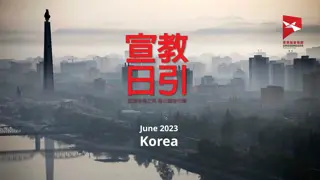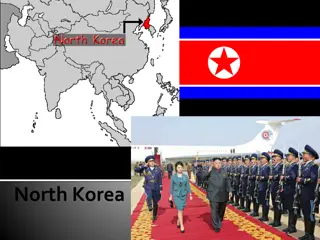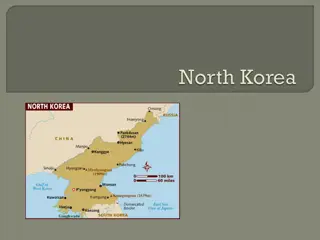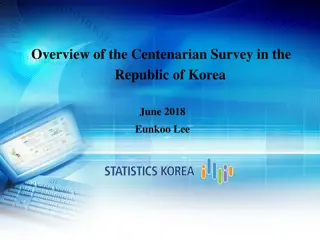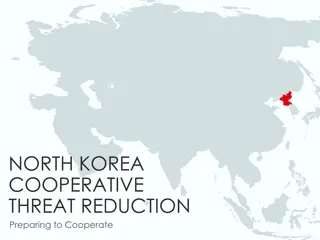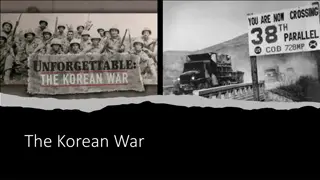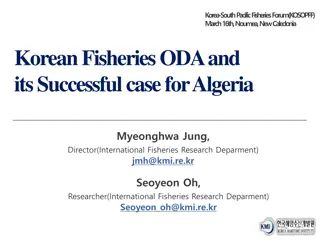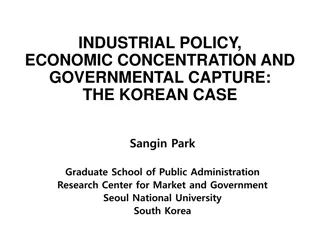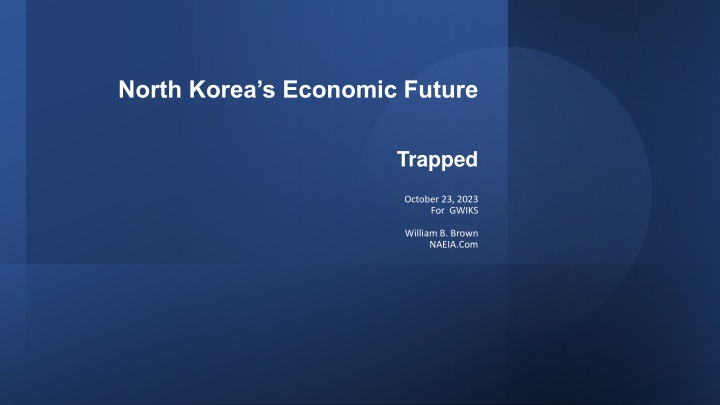
The Future of North Korea's Economy
This presentation dives into the economic challenges facing North Korea, analyzing its monetary issues, growth factors, and production efficiency from a variety of perspectives. Explore the nation's economic history, current state, and potential paths forward based on theories and data.
Download Presentation

Please find below an Image/Link to download the presentation.
The content on the website is provided AS IS for your information and personal use only. It may not be sold, licensed, or shared on other websites without obtaining consent from the author. If you encounter any issues during the download, it is possible that the publisher has removed the file from their server.
You are allowed to download the files provided on this website for personal or commercial use, subject to the condition that they are used lawfully. All files are the property of their respective owners.
The content on the website is provided AS IS for your information and personal use only. It may not be sold, licensed, or shared on other websites without obtaining consent from the author.
E N D
Presentation Transcript
North Koreas Economic Future Trapped October 23, 2023 For GWIKS William B. Brown NAEIA.Com
Quick theoretical look at the North Korean Economic Problem and suggestions as to where it is going. I In Depth Look at NK Monetary Issues Website NAEIA.com naeia.com Analysis Tab -- this presentation Sept 18: North Korea Exchange Rate Pressures Stinson 38 North Thanks to Kim Byong Yeon: Unveiling the North Korean Economic Collapse, 2017 Brown, Chapter Two: Kim Il Sung s Juche Economy in Chiang Min-hua, North Korea s Political Economy, 2022 The Political Economy of North Korea: Domestic, Regional, and Global Dynamics: Chiang, Min-Hua: 9781955055451: Amazon.com: Books Brown, Features of International Sanctions on North Korea, Korea Development InstituteKi n NEIA.com Trapped Between Plan and Market: Implications for North Korean Stability William B. Brown NAEIA.com 2
William B. Brown NAEIA.com Growth in GDP is a function of: More Inputs of Capital, Labor, Land, Natural Resources Efficiency in use of these inputs. TFP. Capital inputs supplied by Capital Stock which is built by savings over time employed as investment. It depreciates to create NDP. Savings equal production less consumption. Economic Growth Socialist or command systems grow by forced saving and investment, increasing capital stock, as determined by state planners. Markets, money interfere with the plan. Fixed wages and price, weak incentives and slow adjustment, are problems. Capitalist systems grow by efficiency, changing use of inputs, as determined by competition and as prices force adjustments. Monopoly interferes with competition, and externalities, require regulation. 6/23/2023 3
William B. Brown NAEIA.com Subsistence Economy, no savings possible. Poverty Trap Growth can come only via external sources of savings/investment, foreign aid, or Efficiency Change 6/23/2023 4
Production efficiency Stylized Economic Systems Rule by money Rule by ration Command (state) Mixed Market (private)
Production efficiency Stylized Economic Systems US 2008 << US 2023 China 2023 < > USSR 1957 > China 1978 >> Law of one price Two prices Many Prices Command (state) Mixed Market (private)
Production Efficiency North Korea: Caught in the Middle 1960 2017 2023 1995 Command (state) Mixed Market (private)
Production Efficiency North Korea s Double Trap 1960 2017 2023 Poverty Trap 1995 Command (state) Mixed Market (private)
What We Think We Know A Very Poor Country GDP in 2021 about $27 bn. BOK estimate Population 26 million Per-capita GDP $1,000 - $2,000 180 in the world NY Times reports $1,184.79 in 2020 ! Negative growth 2020-22 Malnutrition, extreme poverty is prevalent William B. Brown NAEIA.com 9
Why is North Korea So Poor? Hint: Its not for lack of capital and resources, or culture Excellent natural resources per capita Nonferrous and iron metals Hydro power Coal Relatively low pop density for East Asia Excellent geography Excellent human capital relative to income Much industrial capital Well organized ancient civilization William B. Brown NAEIA.com 10
AnswerWeak productivity North Korea s system makes poor use of its ample physical and human capital resources probably the worst in the world. Why? Two issues, one micro, one macro Mixed command and market system delivers poor economic decisions. Two prices for everything. Partial dollarization fixes inflation but impedes monetary policy, starves state economy. Trapped between both systems. Poverty trap plus transition trap. William B. Brown NAEIA.com 11
Not Always This Way: 1945 in Good Shape Probably in better shape then rest of Asia. No WWII in Korea. 1910-45 Japan built up infrastructure and industry in northern part of its Korean colony. taking advantage of mineral resources and hydro. avoiding US bombing launchpad for invasion of China Russians counted 1,400 factories taken over by socialist state in 1945 Korean War devastating but Soviet, EE, and Chinese aid built back quickly. William B. Brown NAEIA.com 12
1956-1976 Golden Age of NK Socialism By 1949 all industry socialized. By 1956 all farms collectivized. Central plan economy replaced ancient money/market economy Trade was strong with bloc countries, Japan and Europe. US rules prevented trade. Russians and Chinese criticized Kim Il Sung for too much investment, not enough attention to living standards, and weak exports but industry grew rapidly. 1976, prior to devastating default on western credits, probably peak year. Downward spiral ever since. William B. Brown NAEIA.com 13
Zhou Enlai and Kim Il Sung, circa 1960 Kim is visiting China trying to obtain more industrial aid Zhou: We notice, looking across the river (Yalu) that you never have to turn off your lights. You have developed socialism far faster than we have. KIS: Yes, but it is with your help. Zhou: That is because you are holding down so many American forces, thus protecting the entire socialist world. (Wilson Center Archives) William B. Brown NAEIA.com 14
1997 Lights out 1997 Lights out 6/23/2023 William B. Brown NAEIA.com 15
Command Economy Results Marxism Ownership of capital (means of production) is by state or collective, no private ownership. Rejects market prices for capital and labor. State sets prices high for consumption goods, low for investment goods. Allocation by decree via central plan. Plan emphasizes material growth via high investment, low consumption Divergent price systems prevents normal trade, investment with capitalist world. Strong central state High share of investment rel. to consumption. Labor is paid rations, not money. No money economy creates dependent public. No personal financial savings. Individual incentives weak, poor productivity Limited gains from trade COCOM Supply Chain Nightmare! All Marxist economies experience massive famine, dissolution. Except North Korea 6/23/2023 William B. Brown NAEIA.com
Capitalist, Market Economy What is a Market? Marketization: Much more than marketplaces Private ownership of means of production Requires competition, the force. Many sellers, Many buyers Rules, Structure Time, currency, behavior Compete for best price Market clears with flex price Usually most efficient outcome Decentralized, Unplanned Law of One Price Goods Markets Services Markets Labor Markets Real Estate/Land Markets Capital/Finance Markets Foreign Exchange Markets William B. Brown NAEIA.com 18
Allowed foreign currency to circulate at will. As in other dollarized economies, this dampened inflation. Creates new good for citizens to use their won to purchase. First time NK people had a financial savings vehicle US dollars. Private savings must have soared, stopping inflation. Kim Jong Un s Kim Jong Un s Half Half- -Step Financial Financial Reforms Reforms Step Encouraged factory autonomy, gave them pricing and production authority. How much is open to question. Market pricing would increase productivity, dampen inflation by creating new products. Especially in tech sector. New Central Bank law in 2015 gave CB authority for exchange rate and loan activity, not Finance Ministry. William B. Brown NAEIA.com 19
Pilot program aimed to decentralize farms stalled out. But reform not But reform not extended to extended to farmers and state farmers and state employees employees of the population of the population Many state enterprises excluded, required to support Plan. most most State set prices for key goods, like electricity, remained far to low. Most importantly, without property rights, private savings flowed to US dollars and yuan cash and not to productive investments. Exception was small scale entrepreneurs, donju, and housing. Macro-economy thus shifted from (state) investment-led to (private) consumption-led. No increase in aggregate demand so no inflation. William B. Brown NAEIA.com 20
Most critically, state wages remained at fixed low rates while market, productivity related wages, soared. And dual wages And dual wages system exploded, system exploded, leading to massive leading to massive state corruption. state corruption. State wages set at 3-5,000 won per month, with declining value of ration perquisites. Private wages soared to 300,000 won per month with no ration privaledge. Investors could make much more. William B. Brown NAEIA.com 21
North Korea Foreign Exchange Rate Pressures Control by Money? For: US Department of Treasury, Korea Development Institute September 14-15,2023 William B. Brown NAEIA.Com
Kims Biggest Success North Korea Won Per US Dollar September 2012-August 2023 10,000 9,000 8,000 7,000 6,000 5,000 4,000 3,000 2,000 1,000 0 2012 2013 2014 2015 2016 2017 2018 2019 2020 2021 2022 2023
Last 4Years North Korea Won per US Dollar Sep 2019- Aug 2023 10,000 9,000 8,000 7,000 6,000 5,000 4,000 3,000 2,000 1,000 0 Sep Dec Mar June Sep Dec Mar June Sep Dec Mar June Sep Dec Mar June
Dollarization Kim Jong Un s Letter to Assembled Banking and Finance Functionaries in Pyongyang, 2015 The sovereignty of the country is being violated as currencies of other countries are publicly circulating at home, but the financial and banking sector has not taken decisive measures. The flaws appearing in financial and banking work owe to the fact that the functionaries of this sector lack the revolutionary consciousness that they are the masters in charge of the country s economy, have fallen into defeatism, and are unable to implement with a do-or-die spirit the party s fiscal and financial policies. Lee and Carlin, 38 North William B. Brown NAEIA.com 26
China-North Korea Trade Jan 2015- August 2023 400 Tough UN Sanctions 350 300 million US dollars 250 200 150 Covid Border Closure 100 50 0 01/2015 01/2016 01/2017 01/2018 01/2019 01/2020 01/2021 01/2022 ChX ChM
China Trade Surplus with North Korea Jan 2015 - July 2023 China Customs (excludes crude oil) 300 250 200 MILLION US DOLLARS 150 100 50 0 Conjectured non-trade net income Jan-18 Jan-19 Jan-15 Jan-16 Jan-17 Jan-20 Jan-21 Jan-22 Jan-23 -50 China Customs
China Visible Trade Surplus with North Korea Jan 2015 - July 2023 China Customs (excludes crude oil) 300 250 200 MILLION US DOLLARS 150 100 50 0 Conjectured non-trade net income Jan-18 Jan-19 Jan-15 Jan-16 Jan-17 Jan-20 Jan-21 Jan-22 Jan-23 -50 China Customs
Implied North Korea Visible Trade Deficit with China Jan 2015 - July 2023 China Customs (excludes crude oil) -50 Jan-15 Jan-16 Jan-17 Jan-18 Jan-19 Jan-20 Jan-21 Jan-22 Jan-23 0 50 MILLION US DOLLARS 100 150 200 250 Conjectured non-trade net income 300 China Customs
China Yuan per US Dollar China Yuan per US Dollar Pyongyang cross Pyongyang cross- -rate; 2021 rate; 2021- -23 23 12.000 11.000 10.000 Pyongyang Cross rate 9.000 8.000 7.000 Fed Reserve 6.000 5.000 4.000 May June Jul Aug Sep Oct Nov Dec Jan Feb Mar Apr May June Jul Aug Sep Oct Nov Dec 2023 Feb Mar Apr May June July Aug
William B. Brown NAEIA.com Financial panic plunge in won exchange rate, jump in won prices. Forces reforms. Elite complaints, loss of dollars, crackdowns Firm s failure, can t meet ration or pay requirements Labor unrest, unequal treatments (but no labor unions) Military unrest, bad living conditions, no future Peasant revolt, withholding grain supplies. Regional uprising, far from center. Potential Origins of Instability Population probably won t blame Kim regime but second , third order hierarchy. Local Workers Party cells possibly take hit. Offsets. No alternative leadership. Weak organizations. Worry of foreign intervention. 6/23/2023 33
Dangerous Lack of Progress: Financial Issues Can Spark Unrest, Reform or Collapse Wage and income differential between state sector and private sector seems to be widening. Trouble brewing for state industrial workers . (Poland example, not yet). Use of money creating private financial markets. Lack of regulation, laws, creates domestic hostility. Reaction appears to target private incomes. Corruption increasing rampant. Dollarization helped stop inflation but inevitable speculation between currencies. Borrow in one, lend in the other. No bankruptcy laws. Fights. Factory managers have more authority to adjust prices, procurement, and distribution but irrational prices leads to irrational results. State faces balance budget requirement due to dollarization, tight money. No investment is the result. Deteriorating infrastructure. William B. Brown NAEIA.com 34
Conclusion: Kims singular achievement is in danger. Kim s singular economic achievement, exchange rate and price stability, is in big danger with potential to disrupt the political and economic system. Inflation and money theft does that. Public has much more power than in previous regimes given their private holdings of foreign exchange, yuan and dollars. State has less control. Tight monetary policy has pushed economy into severe recession. Textbook solution is to sell state assets to private sector thus easing budget constraint, while raising state salaries, increasing prices of state supplied goods, and allowing property rights to encourage private sector productivity. State budgets and wages are severely constrained due to need to protect won against circulating dollars and yuan. This could be done even in UN Sanctions environment. William B. Brown NAEIA.com 35
Chinese Construct, the order is important. Reform Reform then then Open Open Reform in NK context means: Unify price and wage system Establish some private property rights Decollectivize agriculture Create new money and banking system, using interest rate to encourage private savings and direct investment to best uses. (SK model) Raise pay but shrink size of huge bureaucracy and military Privatize significant state assets including major factories. Establish tax system and transparent budget. This could put economy on moderate growth track, without foreign opening. Reform then leads to Opening, and massive engagement with rest of world. Breakout economic growth would ensue. William B. Brown NAEIA.com 36

